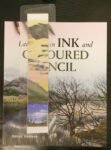Here's the review of the second of the three books on coloured pencil that I…

Drawing Animal Portraits In Coloured Pencil, Lisa Ann Watkins – Book Review
I’ve finished reading the first of my Christmas books. This was a 144 page paperback, one of those paperbacks with the glossy covers that are a few inches too big and bent back inside, so will never end up dog eared.
Contents-wise it’s roughy split into three equal pieces: an introduction, then two sets of exercises on studies and portraits.
First up is the introduction. It includes some stuff very specific to this book’s subject matter on how to get good source photos. And then there’s obviously stuff on materials, mark making, colour. This is the third book I’ve read on coloured pencils and I’m amazed that I keep learning things from these introductory chapters, something that I very rarely do with introductions to watercolour books. I like how Lisa described drawing surfaces as mountains and valleys and used this to explain their capacity for holding colour. There was also some useful stuff on the pressure to apply and on how to tell when the surface is full to capacity.
The second and third chapters are quite similar and worth describing together. The chapter in studies refers to doing paintings of individual elements like eyes, noses and fur. This is something I’ve seen in a Jean Haines book but Jean made the very important point that if you can get an animal’s eyes right, you’re well on the way to a likeness and, indeed, Jean often stops early without drawing a whole portrait. Lisa, though, doesn’t make this point, presenting the studies, instead, as just one of lots of things that have to be just right in the final portrait.
I always like to comment on where books like on the instruction vs demonstration spectrum. Lisa is right up there at the instruction end, as extreme as I’ve ever seen anyone. She tells the reader exactly what pencils to use (colour and manufacturer), what surface to draw on, even what technique to use in each exercise to transfer the shapes from the source photo to the drawing. I like instruction books that set us exercises and books that do demonstrations but Lisa’s modus operandi here is I’m going to do a painting and you have to copy everything I do religiously. Not my cup of tea. I’m not surprised when books like this get reviews on Amazon from people complaining about having to buy loads of gear. It’s the only way to learn if you’re buying into Lisa’s mode of teaching. Me, though, I don’t buy into that. Instead, with books like these, I’ll treat those follow me exercises as demonstrations and look for lessons from them.
And there are lessons there. I counted six. The most interesting thing for me was the number of layers that Lisa uses in paintings. She’ll put on (say) six layers of different colours and then I’ll be expecting her next step to be burnishing but instead step 7 will be to repeat steps 1-6 several more times until the surface feels like it can’t take in any more colour. This is very different to what I’ve seen in the first two books I’ve read on coloured pencils. In fact Lisa doesn’t mention burnishing at all in her book. This feels like the biggest takeaway from the examples. I say that, but the photos in the examples are also useful. There are so many places where the photo looks like somewhere I’d be happy to stop but where Lisa carries on.
Just as with the Arlene Steinberg book, I found the demos to be a bit boring and repetitive after a while. I did wonder why there were so many but I think I found the answer. In this book, the five full portrait demos (two dogs and a cow, horse and cat) were on four different surfaces and I think Lisa wanted to demonstrate how the approach to all these different surfaces differed. In which case, I wish they’d had labels on the contents page like how to paint on crescent suede mat board rather than how to paint Brandy, the red Angus cow. When the same techniques apply to different animals but different techniques apply to different surfaces, it would help if the author made this clearer by how she structured things.
I’m dotting about a bit here, but there’s something I was a little disappointed to find missing from the book. And that was about getting down a good initial drawing. There’s lots of talk about all the different ways of using tracing paper (yes, there are lots of different ways) but nothing about drawing freehand or even about copying images using grids. So, bit of a hole there in my humble opinion.
The artwork in the book is amazing. Not as unrealistically photorealistic as someone like Alyona Nickelsen (thankfully), so some artists will be inspired by it and aim for something of similar quality. It’s almost certainly beyond my reach, but even if I can never get there I can actually see the direction I need to head in.
Overall, I learned stuff from this which will change the way I use coloured pencils. Despite my issues with Lisa’s instructional style, this means it scores a respectable three palettes. I still dream, though, of coming across the perfect beginners’ book on coloured pencils at some point. After reading this one, I wonder whether that book I’m looking for might not even be marked up as a beginners book but instead be about a particular style or subject matter and have a really great introduction.
🎨🎨🎨
You can find this book and more reviews of it at Amazon UK here. As an Amazon Associate, I earn commission from qualifying purchases but this costs absolutely nothing extra to you.








Leave a Reply